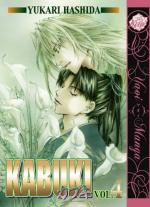|
This section contains 5,772 words (approx. 20 pages at 300 words per page) |

|
SOURCE: Leiter, Samuel L. “The Kabuki Juhachiban.” Literature East & West XVII, Nos. 2-3-4 (June-December, 1973): 320-34.
In the following essay, Leiter discusses the different styles used in the collection of plays known as Juhachiban, or “Kabuki Eighteen,” and describes some of the most popular plays from the group, noting the Japanese fondness and reverence for these pieces, partly because of their association with the prestigious actor-family of Ichikawa.
In the classical Kabuki play, Narukami, first presented in 1684, a young princess, Taema-no-hime, has come to the mountain retreat of the priest, Narukami, to trick him into releasing the rain-god, whom he has captured. Her method is seduction. When she feigns illness the priest undertakes to cure her and the following dialogue ensues:
TAEMA-NO-HIME:
… Oh, it pains!
NARUKAMI:
How pitiful. … Here, let me massage you a little.
TAEMA-NO-HIME:
That would be more than I deserve. How could I ask a...
|
This section contains 5,772 words (approx. 20 pages at 300 words per page) |

|


